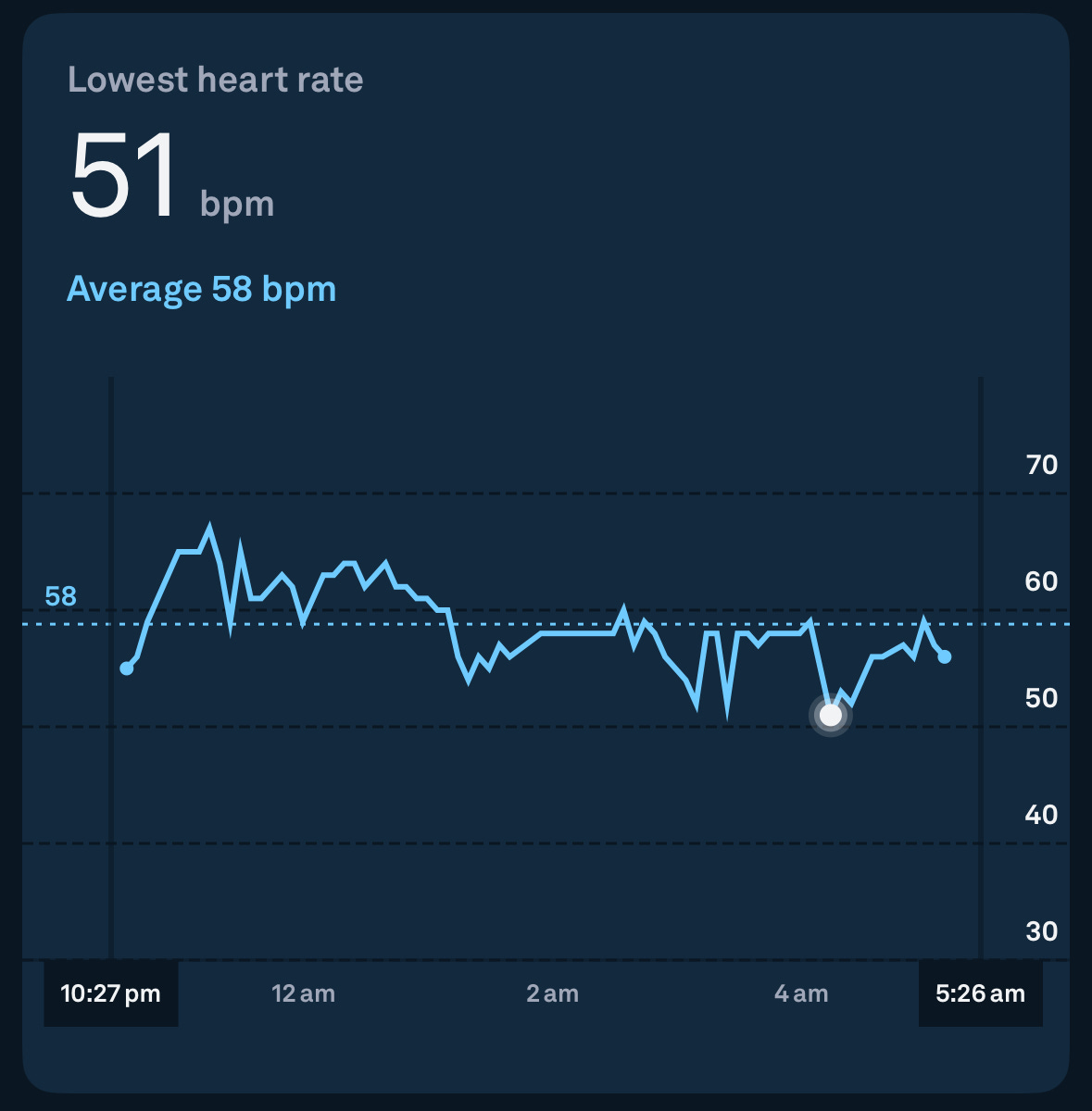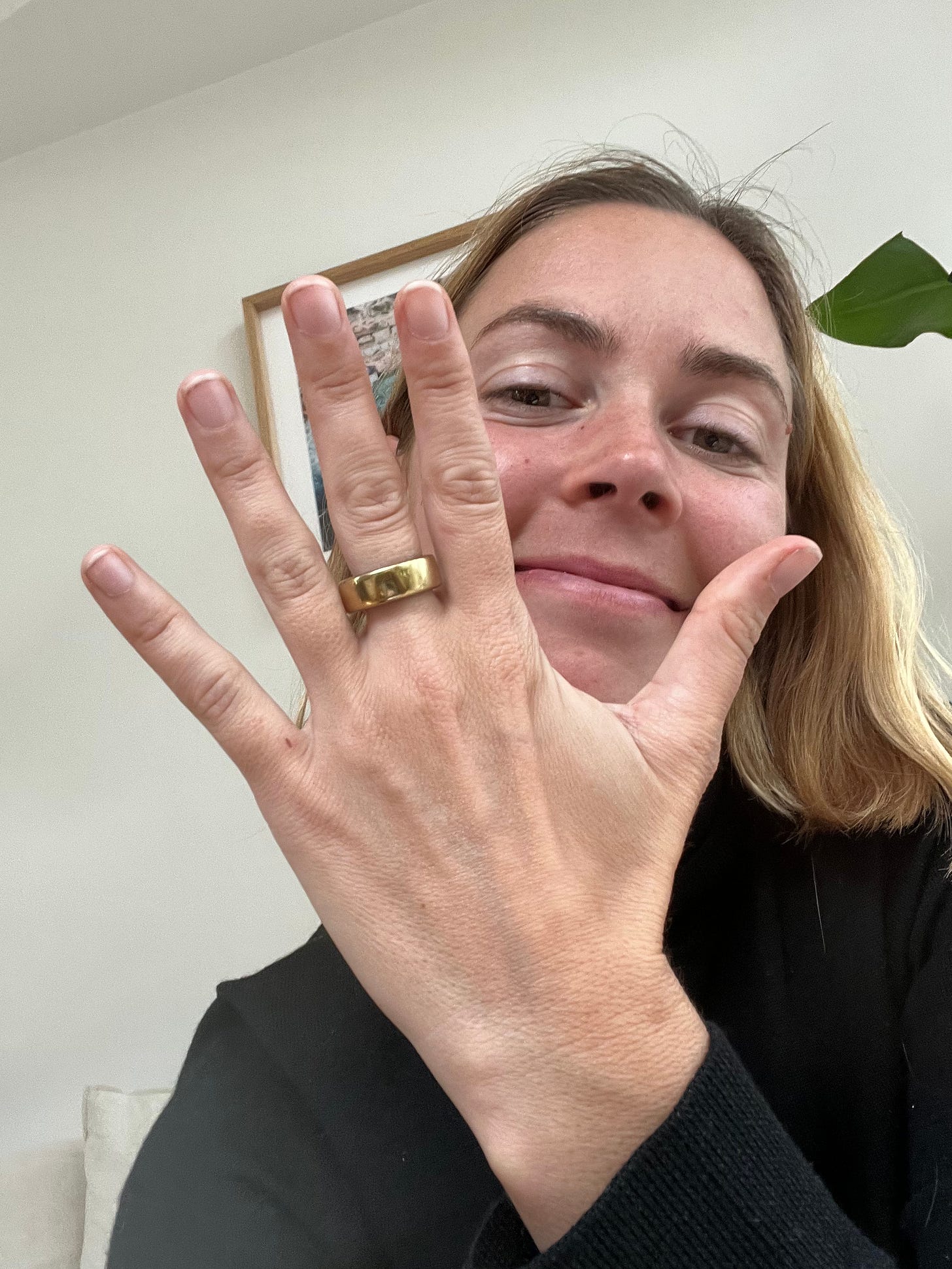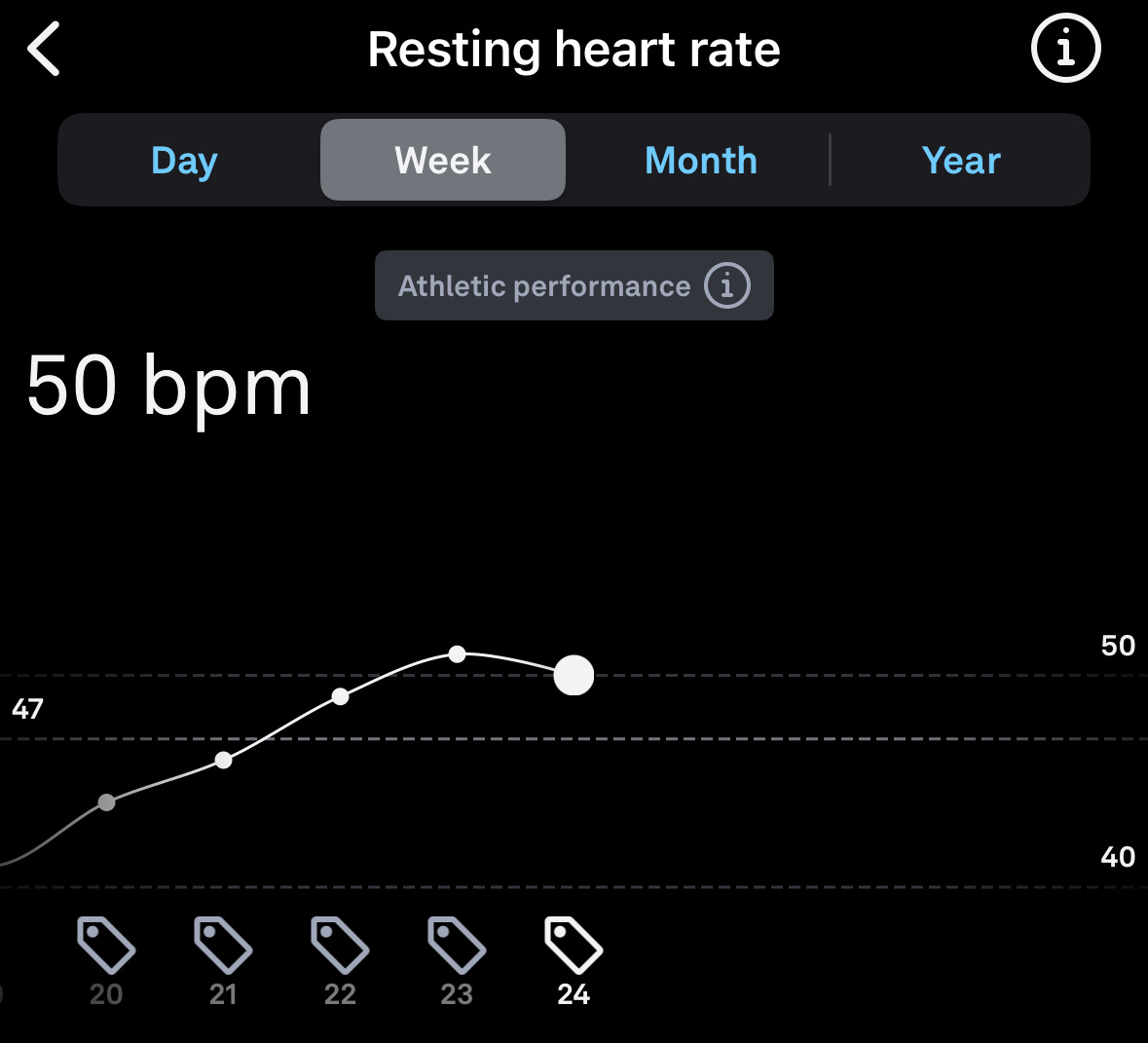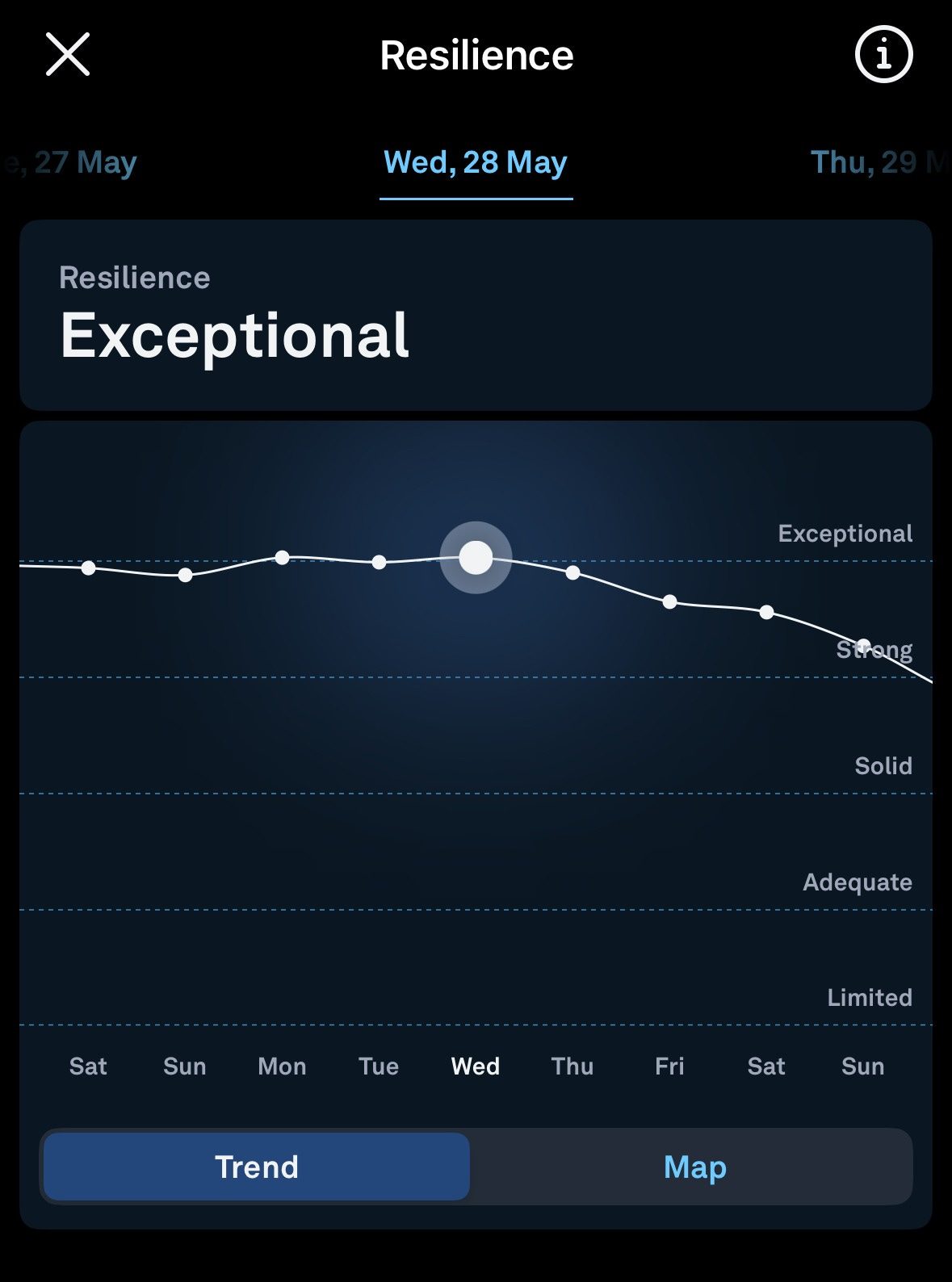Hi pals!
For the uninitiated: an Oura ring is a “wearable smart ring that tracks various health metrics, including sleep, activity, and readiness, to provide a comprehensive view of your wellbeing”
It promises comprehensive health & sleep tracking, stress management, movement analysis, menstrual cycle tracking, personalised insights, motivation and habit formation, early detection of health issues, and the keys to a long happy healthy life of smug wellness.
Here’s me with mine!!
We get asked soooo much whether they’re worth it as they’re very expensive (you can get them on sale but still at least a few hundred $$ AUD + a $10 monthly subscription).
It’s always too hard of an answer to fit into a few minutes at the end of an episode so I decided it would be worthy of its own blog post.
Why’d I get it?
I think I dithered about getting one for about a year before Sean kindly put me out of my misery and gifted me one for my 30th birthday.
I already knew I was SUPER curious about getting a wearable that gave me insights into my health and performance. I am a bit of a data nerd and knew I’d find it really interesting. I also had an idea that it might help me listen to my body (haha) and find a better work/run/life balance.
I thought hard about whether I wanted an oura ring or a whoop band. To me it came down to two things:
(1) I valued sleep data more than exercise data because my garmin already tracks exercise pretty well, and
(2) I had the idea that a ring would be less annoying generally than an armband, and I knew I would have to wear it constantly to find it useful.
I’ve now worn it for over a year and am excited to dive in to whether it’s worth the hype.
I’ll break down what I like/dislike (including how I apply it to my life e.g. make changes off the back of it as I struggled to find this info when I started out) and then finish with some conclusions about whether I’d recommend it and who to.
What I 🩵 about it
1. Trends
The danger of wearables, in my mind, is largely when you are overly reactive to individual data points (a poor sleep, a drop in HRV). For my oura ring data, I try to keep a ‘lines not dots’ mindset, and for this, nothing is better than looking at ‘trends’.
Here’s what I pay attention to:
Total Sleep
Total sleep = total time asleep.
I think for most people ‘sleep score’ is probably a more interesting trend as it’s likely a more accurate overall assessment of sleep quality.
For me, my total sleep and sleep score are strongly correlated (Oura tells you this stuff too!) - if I’m sleeping for more than 7 hours, my sleep score will be high - and total sleep feels more like it’s more in my control and therefore more productive for me to focus on.
Real-world application: I like keeping an eye on my weekly sleep average. If it’s dropping too close to 6 hours, I’ll make a really conscious effort to reset for the following weeks e.g. maybe cancel some weekday evening commitments or move some early morning runs to be lunch runs.
I once did a review and every single time I’ve been sick over the past 18 months has been preceded by consecutive weeks of low total sleep (shocking!!).
Resting HR & Recovery Index
Lowest Resting Heart Rate = your lowest RHR value captured during the night
Recovery Index = the time spent sleeping after the heart rate lowers to its lowest point during the night
Over my time using the ring, I think if there is one data point that will tend to be predictive of how good I’ll feel when running, it’s my RHR and recovery index. A great example of this is when I’m recovering from an illness. I can be symptom-free, but if my RHR is still high, I’ll still feel kinda rubbish when I try to push with my running.
Recovery index is a super interesting one. Oura says that the earlier your heart rate stabilises (reaches it’s lowest point) in the night, this is a sign that it’s recovering well from the activity and stress of the day.
If it’s taking all night to recover then this can be a signal you’re overtraining or under recovering.

I’ve noticed my recovery index is poorer when my load increases but I’m not making any effort to recover more (e.g. sleep more).
It’s also a great indicator for me that I’m not getting my nutrition right - e.g. another example is when I’m travelling for work and struggling to eat as much food as consistently as I usually would - my body clearly struggles more to recover overnight.
Again, I’m more interested if this is a trend for 3+ nights in a row, rather than as a one off.
Real-world application: If my RHR has been >3-5 BMP higher than average for more than a few days, I’ll slightly adjust my expectations of how I’ll feel particularly in sessions and just make a bit more of an effort to tune in.
If my recovery index has been on the low side and I don’t feel like anything can give on the work/social front, I’ll look at how else I can adjust my load to give my body a little more time to recover.
2. Temperature tracking
This is such an amazing feature!! For women it essentially means that your Oura ring can, with shocking accuracy, tell you what point in your cycle you’re at (you can also connect it with a sister app called Natural Cycles that gives you wayyy more intel from this data).
I didn’t actually know how closely small fluctuations in your body temperature were linked with different stages in your cycle.
For me, I have never tracked my cycle and if you’d asked me on any given day where I was at in my cycle I would have had no idea. Now I have daily insights into this and always know exactly where I’m at and it’s actually soooo cool!

Real-world application: I’m still learning to understand how I personally should be adjusting my activity/lifestyle at different stages of my cycle as it does seem to be highly individualised.
There are some alarming stats about how many women are unknowingly overtraining to the point of disrupting their hormones so just seeing things tick along as expected is even nice.
It has also genuinely helped me feel more in touch with my body and have a little bit more empathy for what it’s doing.
3. Resilience
Stress Resilience = an estimate of your ability to withstand physiological stress and recover from it over time.
I actually tossed up for a while on whether to put this in do like or don’t like - I have only very recently come to understand how helpful this data point is.
Resilience is quite an opaque data point to understand. It takes into account your daytime stress levels, daily restorative time, and night time recovery over the past fortnight. As a result, it only changes gradually.
The turning point for why I like this metric is because it’s taught me that taking care of my body and recovery is protective for the times where I’m not able to do so as well.
For example, when I am in a period of having higher resilience scores, if something happens e.g. I have a few nights of not enough sleep, it doesn’t actually have a huge impact on how I feel at work or when running.
Alternatively, say my resilience is already low and then I get sick, it will tend to take me a lot longer to recover.
Real-world application: I think the tricky part (and why I used to not like this score) is when a data point is really just a combination of measures that are a combination of other measures, it feels further and further removed from what I can impact.
If my resilience gets really low then honestly the only thing that helps reset it is a holiday, where I can sleep more and chill during the day. Which is not always possible!!
But I have grown to love the thesis that you can bank good few weeks of sleep and good recovery to help you cope better when those things inevitably get thrown off course in, say, a really busy week at work. I find that super motivating.
I’ve just decided to make this a two-parter because I’ve accidentally gone way more in-depth than I intended to and this is getting obnoxiously long.
Part two (next weds!!) will include what I realllllly don’t like about my oura ring, as well as my concluding reflections on whether I think it’s worth it, who for, and the impact it’s really had.
In the meantime, I’m curious to hear - if you’ve got an oura ring, what do you love about it? If you don’t, what do you want to know about it? Any other wearables people prefer out there?
Hoo roo!







